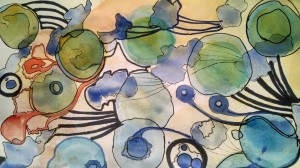“…it is possible for thought-processes to become conscious through a reversion to visual residues [and] in many people, this seems to be a favorite method…Thinking in pictures…approximates more closely to unconscious processes than does thinking in words, and it is unquestionably older than the latter both ontogenetically and Phylogenetically.”
Freud, The Ego and the Id
Self-image is the visualization of our personality. It is an internal family of characteristics, which includes our emotions and experiences, forming a collective representation of both the positive and negative side. Parents and caregivers are the biggest influence on our self-image. In the beginning stages of life, parents’ emotional expression is mirrored in the child and shows them how to begin to manage emotion. Teachers, friends, and family make the next biggest impact. All of these influences tell us what we think and feel about ourselves. Whether a real or distorted view, we become very attached to this view. This image is ever evolving and shapes how we take in information and evaluate ourselves. It determines whether we see a positive or a negative self-image. Both are internalized and affect how we act.
Richard Schwartz writes “[Bulimic] clients are heavily embedded in protective or conflictual sequences within their families, such that they are perceived and perceive themselves as pivotal to their families survival; others have been chronologically ignored or rejected by key family members, and are not particularly protective of their families” (*Schwartz 25). It is my observation, people with Bulimia are as much influenced by the external family as the internal emotional family. When treating Bulimia, the Internal Family Systems (IFS) model offers an excellent conceptual umbrella under which a variety of practices and different approaches can be integrated. Eating Disorder treatment requires many tools from the psychotherapy tool chest. I have drawn from DBT skill sets, art therapy, and even EMDR, in addition to the IFS techniques.
IFS relies heavily on imagery and visualization of one’s personality. The personality is represented by what Schwartz calls “parts”. These parts are the sub-personalities that we all have. IFS allows different sub-“parts” of a person to express themselves and receive the compassion that they need from the higher “Self”. Schwartz makes the distinction that there are no “bad” parts of you. Parts may become extreme and conflicting parts become polarized as a result. IFS therapy is to help the parts become less extreme.
At the onset of treatment a client is asked to communicate with the “parts” of their personality. They imagine an internal conversation with the “part”, and then through the Gestalt empty chair technique, they externalize the conversation by communicating with it as if it were in the room. When I do this enactment with clients I ask them to make a visual representation of a “parts”. At times there have been 3-4 internal family members or “parts” in the room. The interaction of these “parts” can be indicative of the client’s experiences with their family of origin.
Why the extra step of visual representation of “parts?” Creativity is an integrative brain function. It calls upon both analytical and intuitive process. By engaging the creative part of the brain it brings attentional focus to “parts’ ” emotional experience and at the same time utilizes analytical functioning that distances the attachment to the “parts.” This distancing allows the person to have a mindful awareness of the “parts’ ” roles in their internal dynamic. In my practice of IFS I have learned to foster greater acceptance for my own thoughts and feelings or “parts”, other people, events beyond my control, and the beliefs I held at any given moment.
Timothy D. Brewerton, MD identified a link between PTSD and eating disorders using data from the National Women’s Study. The study shows PTSD is very prevalent with those who have a diagnosis of bulimia nervosa. This same is true for those diagnosed with binge eating disorder. IFS defines traumatized “parts” to be the “exiled” experiences and events in our lives. We have very little tolerance and acceptance that these things took place. However until one can reach an acceptance, the individual continues to suffer. In order to increase the acceptance of my clients internal “parts” I give my clients the directive of making a “mindful awareness painting” of their emotions. Since most parts represent emotional experience, it creates a greater acceptance of ones life experience. The image can be abstract or a representational. The important piece is that they start to have an externalized conversation. There are many other benefits to this process. The damaged or impaired brain can begin to reintegrate its functioning. The act of making art stimulates many areas of the brain and causes endorphin release, which makes us feel good and helps to keep us going through exertion. I have observed that this increases willingness and tolerance of working through a trauma.
For those of you using Internal Family Systems and Art Therapy I would love to hear back from you as to what your experiences have been. Feel free to post images that you have created or have permission to use from someone you’ve worked with.
*Internal Family Systems Therapy. Richard C Schwartz – New York – The Guilford Press – 1995

